You guys rock! I've been coming here for weeks identifying the birds in our backyard for my daughter's school project. Thanks so much for this valuable resource.

Sparrow sized, slate gray plumage with white outer tail feathers.
Adults are generally grey on top with a white belly. The white outer tail feathers flash distinctively in flight. The bill is usually pinkish. The males tend to have darker, more conspicuous markings than the female. Juveniles often have pale streaks and may even be mistaken for a Vesper Sparrow until they acquire adult plumage at 2 to 3 months. There are several regional variations:
The Slate-colored Junco (J. hyemalis hyemalis) has a dark slate-grey head, breast and upper parts. Females are brownish grey. It is found in North America in taiga forests from Alaska to Newfoundland and south to the Appalachian Mountains, wintering further south; it is relatively common in its range.
The White-winged Junco (J. hyemalis aikeni) has a grey head, breast and upper parts with white wing bars. Females are brownish grey. It is found in the mid-western United States in the Black Hills of South Dakota and Wyoming, and is relatively rare.
The Oregon Junco (J. hyemalis oreganus) is found on the Pacific coast mountains from southeastern Alaska to extreme northern Baja California. It has (see photo, right) a blackish-gray head and breast with a brown back and wings and reddish flanks. This is the most common form in the west.
The Pink-sided Junco (J. hyemalis mearnsi) has a grey head and breast, with a brown back and wings. It has pinkish-brown flanks. It is found in the northern Rocky Mountains from southern Alberta, Canada to Idaho and Wyoming in the northern United States.
The Gray-headed Junco (J. hyemalis caniceps) is found in the southern Rocky Mountains from Colorado to central Arizona. It is mainly grey on top with a rusty back, similar to the Yellow-eyed Junco except having dark eyes like the other races of J. hyemalis.
The Red-backed Junco (J. hyemalis dorsalis) is found in the southern mountains of Arizona and New Mexico. It has a dark upper mandible and rust-color on the wings, making it still more similar to the Yellow-eyed Junco, with which it does not overlap in breeding range.
Their breeding habitat is coniferous or mixed forest areas throughout North America. They usually nest in a cup shaped depression on the ground, well hidden by vegetation or other material, although they are sometimes found in the lower branches of a shrub or tree. The nests have an outer diameter of about 10cm and are lined with fine grasses and hair.
Photo © Robert Hughes
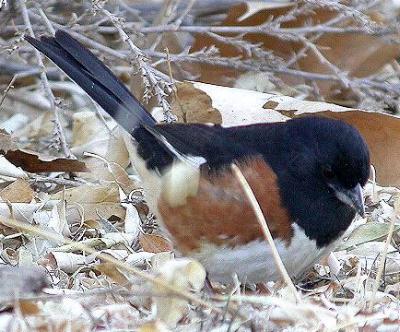
Eastern states only.
The Eastern Towhee, Pipilo erythrophthalmus, is a large sparrow. The taxonomy of the towhees has been under debate in recent decades, and formerly this bird and the Spotted Towhee were considered a single species, the Rufous-sided Towhee, sometimes called a chewink.
Adults have rufous sides, a white belly and a long dark tail with white edges. The eyes are red, white for birds in the southeast. Males have a dark head, upper body and tail; these parts are brown in the female.
Their breeding habitat is brushy areas across eastern North America. They nest either low in bushes or on the ground under shrubs.
Northern birds migrate to the southern United States.
There has been one record of this species as a vagrant to western Europe; a single bird in Great Britain in 1966.
These birds forage on the ground or in low vegetation. They mainly eat insects, acorns, seeds and berries.
The call is Drink your teeeee; the word "towhee" imitates this call.
Photo © Andrew Spencer
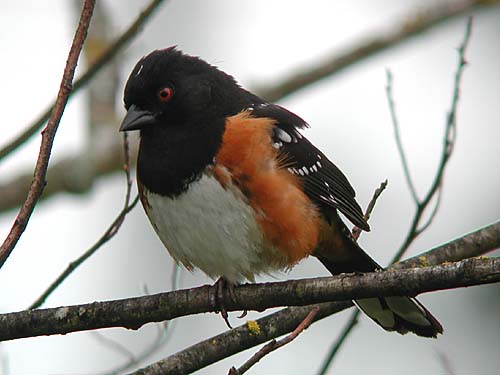
West and midwest
Adults have rufous sides, a white belly and a long dark tail with white edges. The eyes are red. They have white spots on their back and white wing bars. Males have a dark head, upper body and tail; these parts are brown or grey in the female.
Northwestern birds migrate east to the central plains of United States. In other areas, some birds may move to lower elevations in winter.
Their breeding habitat is chaparral, thickets or shrubby areas across western North America. This bird interbreeds with the Collared Towhee where their ranges overlap in southwestern Mexico.
They nest either on the ground or low in bushes, seldom more than 1.5 m above the ground. The female builds the nest over a period of about 5 days. It is bulky and sturdily made of leaves, strips of bark, twigs, forb stalks, and grasses, lined with pine needles, shredded bark, grasses, and sometimes hairs.
At least two broods, consisting of up to 5 eggs, are laid per season. The egg shells are greyish or creamy-white, sometimes with a tinge of green, with reddish brown spots that can form a wreath or cap. The female incubates the eggs alone for 12 to 13 days, the young leave the nest at 10 to 12 days. Nests are parasitized by cowbirds.
These birds forage on the ground or in low vegetation, with a habit of noisily rummaging through dry leaves searching for food. They mainly eat insects, acorns, seeds and berries.
The call may be harsher and more varied than for the Eastern Towhee.
Photo © John C. Folinsbee
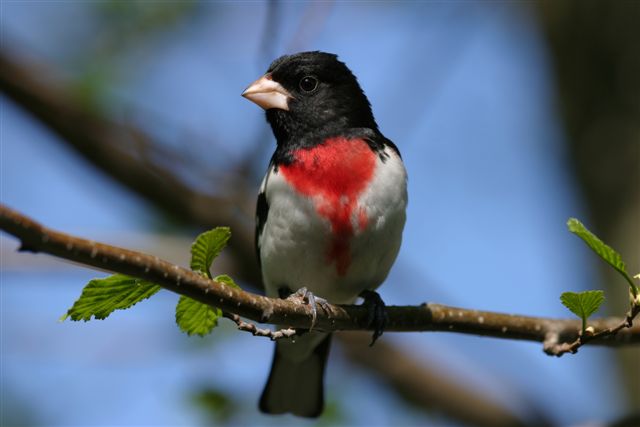
Males are black and white with red breast patch. Females brown with stripes on head. Summer visitor to North and spends winter in central and south America.
The adult is 19 cm long and weighs 47 g. It has dark upperparts, white underparts and a large pale bill. The adult male has a black head, wings and upperparts and a bright rose-red patch on its breast; the wings have white patches and rose red linings. The adult female has dark grey upperparts, a white stripe over the eye, streaked underparts and yellowish wing linings.
The Rose-breasted Grosbeak's breeding habitat is open deciduous woods across most of Canada and the eastern United States. It builds a twig nest in a tree or large shrub.
This species migrates to southern Mexico south through Central America to Peru and Venezuela, and occurs as very rare vagrants to western Europe.
The Rose-breasted Grosbeak forages in shrubs or trees for insects, seeds and berries, also catching insects in flight.
The song resembles a more polished version of the American Robin's. The call is a sharp pink.
Photo © Terry Lunn
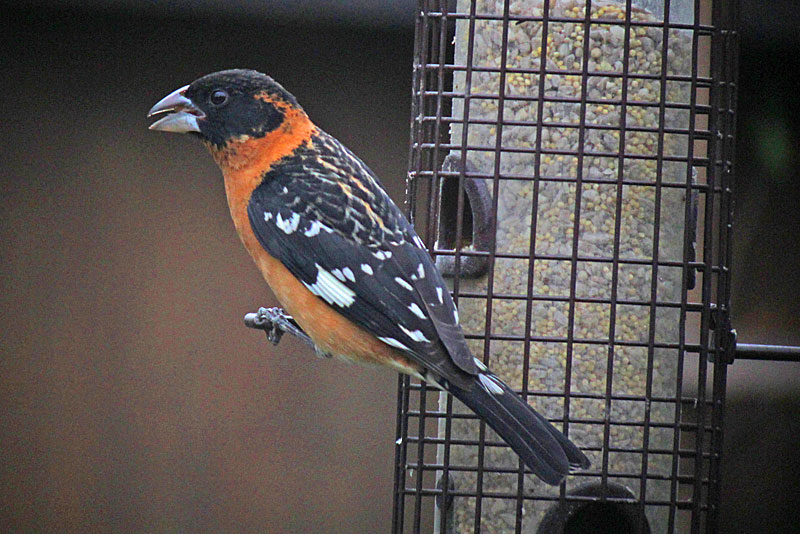
The Black-headed Grosbeak Approximate length: 18-19 cm or 6-1/2 to 7-3/4 inches in length and is similar in size to a starling. As per its name the male has a black head. It also has black wings and tail with prominent white patches. Its breast is dark to tawny orange in color. Its belly is yellow. The female has a brown head, neck and back with sparrow-like black streaks. She also has white streaks down the middle of her head, over her eyes and on her cheeks. Her breast is white and her wings and tail are greyish-brown with two white wing bars and yellowish wing edges.
The Black-headed Grosbeak prefers to live in deciduous and mixed wooded areas. It likes to be in areas where there are large trees as well as thick bushes, such as patches of broadleaved trees and shrubs within conifer forests, including streamside corridors, river bottoms, lakeshores, wetlands, and suburban areas. It also seems to avoid coniferous vegetation.
Nests are built by the female among the dense foliage on an outer branch of tall broadleaved trees or shrubs, 4-25’ above ground and are in the shape of an open saucer. They are made of fine grass, rootlets twigs, bark and conifer needles. The nest is often lined with rootlets, hair, and fine plant material. The female lays 2-5 pale green, blue or grey eggs that are spotted with reddish and dark brown. The eggs are incubated by the male and female for 12-14 days. After the eggs have hatched the fledglings leave the nest in about 11 or 12 days, however they are unable to fly for another two weeks. The young are fed by the adults until they are able to fly. The Black-headed Grosbeak is monogamous, but pair bonds last for only one breeding season and only have one brood per season.
Voice
The Grosbeak’s song is a rich warble that is similar to that of a robin but more fluent, faster, softer, sweeter and mellow with rising and falling passages that make the song much longer than the robin’s. The note is a sharp ik or eek. Both the male and female sing, but have different songs.
Photo © Andrew Birch
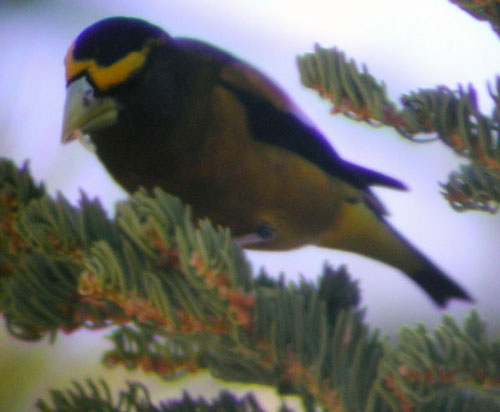
Massive bill and yellow and white plumage.
The Evening Grosbeak, Coccothraustes vespertinus, is a large finch. In the past, it was treated in a genus of its own as Hesperiphona vespertina, but is now usually placed in the same genus as the European and Asian Hawfinch.
The breeding habitat is coniferous and mixed forest across Canada and the western mountainous areas of the United States and Mexico. The nest is built on a horizontal branch or in a fork of a tree.
The migration of this bird is variable; in some winters, it may wander as far south as the southern U.S.
The Evening Grosbeak is 18.5 cm long. The adult has a short black tail, black wings and a large pale bill. The adult male has a bright yellow forehead and body; its head is brown and there is a large white patch in the wing. The adult female is mainly olive-brown, greyer on the underparts and with white patches in the wings.
These birds forage in trees and bushes, sometimes on the ground. They mainly eat seeds, berries and insects. Outside of the nesting season, they often feed in flocks. Sometimes, they will swallow fine gravel for the salts.
The range of this bird has expanded far to the east in historical times, possibly due to plantings of Manitoba maples and other maples and shrubs around farms and the availability of bird feeders in winter.
Photo © Andrew Birch
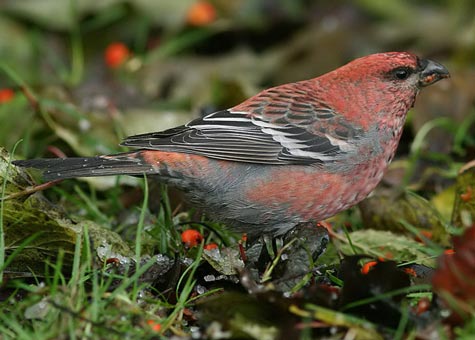
Only found in far north.
Adults have a long forked black tail, black wings with white wing bars and a large bill. Adult males have a rose red head, back and rump. Adult females are olive-yellow on the head and rump and grey on the back and underparts.
Their breeding habitat is coniferous woods across Canada, Alaska and the western mountains of the United States, and in northern Fennoscandia. They nest on a horizontal branch or in a fork of a conifer.
This bird is a permanent resident through most of its range; in the extreme north or when food sources are scarce, they may migrate further south.
This species is a very rare vagrant to western Europe.
These birds forage in trees and bushes. They mainly eat seeds, buds, berries and insects. Outside of the nesting season, they often feed in flocks.
Photo © Arie Ouwerkerk
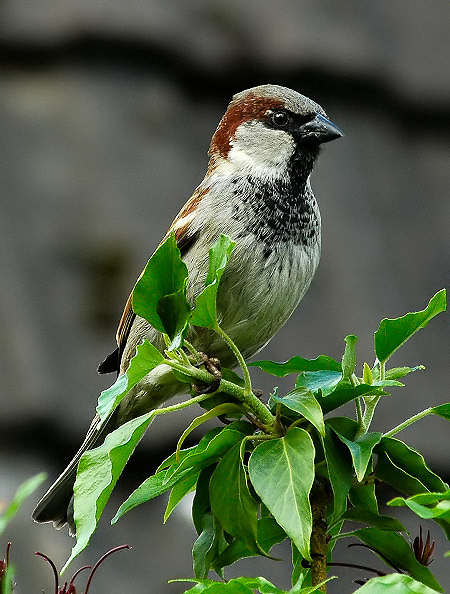
Male top and female below. Common everywhere.
The House Sparrow (Passer domesticus) is a member of the Old World sparrow family Passeridae. It occurs naturally in most of Europe and Asia, though it is replaced by allied forms in some areas. It has also followed humans all over the world and has been intentionally or accidentally introduced to most of the Americas, sub-Saharan Africa and Australia as well as urban areas in other parts of the world. In the United States it is also known as the 'English Sparrow', to distinguish it from native species, as the large American population is descended from birds deliberately imported from Britain in the late 19th century. They were introduced independently in a number of American cities in the years between 1850 and 1875 as a means of pest control.
Wherever people build, House Sparrows sooner or later come to share their abodes. Though described as tame and semi-domestic, neither is strictly true; humans provide food and home, not companionship. The House Sparrow remains wary.
The 14 to 16 centimetre long House Sparrow is abundant but not universally common; in many hilly districts it is scarce. In cities, towns and villages, even round isolated farms, it can be the most abundant bird.
The male House Sparrow has a grey crown, cheeks and underparts, black on the throat, upper breast and between the bill and eyes. The bill in summer is blue-black, and the legs are brown. In winter the plumage is dulled by pale edgings, and the bill is yellowish brown.
The female has no black on head or throat, nor a grey crown; her upperparts are streaked with brown. The juveniles are deeper brown, and the white is replaced by buff; the beak is dull yellow.
So familiar a bird should need little description, yet it is often confused with the smaller and slimmer Tree Sparrow, which, however, has a chestnut and not grey crown, two distinct wing bars, and a black patch on the cheeks.
The House Sparrow is gregarious at all seasons in its nesting colonies, when feeding and in communal roosts.
Although the sparrows' young are fed on larvae of insects, often destructive species, this species eats seeds, including grain where it is available.
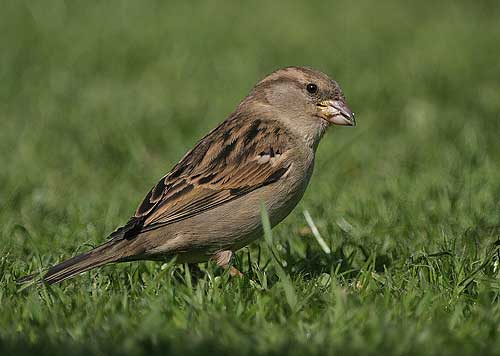
In spring, flowers, especially those with yellow blossoms, are often attacked and torn to bits; crocuses, primroses and aconites seem to attract the House Sparrow most. The bird will also hunt butterflies.
The short and incessant chirp needs no description, and its double call note phillip which originated the now obsolete popular name of "Phillip Sparrow", is as familiar.
While the young are in their nests, the older birds utter a long churr. At least three broods are reared in the season.
The nesting site is varied; under eaves, in holes in masonry or rocks, in ivy or creepers on houses or banks, on the sea-cliffs, or in bushes in bays and inlets. When built in holes or ivy the nest is an untidy litter of straw and rubbish, abundantly filled with feathers. Large, well-constructed domed nests are often built when the bird nests in trees or shrubs, especially rural areas.
Photo © Steve Robinson
Photo © William Bowell
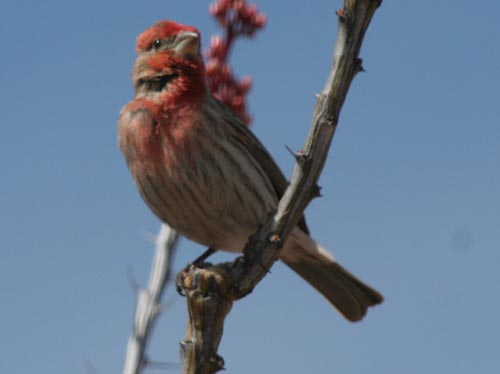
Adults have a long brown tail and are a brown or dull-brown color across the back with some shading into deep grey on the wing feathers. Breast and belly feathers may be streaked. In most cases, adult males have a reddish color to their heads, necks and shoulders. This color sometimes extends to the stomach and down the back, between the wings. The male coloration varies in intensity with the seasons and is derived from the berries and fruits in its diet. As a result, the colors range from pale, straw yellow, to bright orange, to deep, intense red. Adult females have brown upperparts and streaked underparts.
These birds are mainly permanent residents; some eastern birds migrate south. Their breeding habitat is urban and semi-open areas from southern Canada to Mexico.
House Finches forage on the ground or in vegetation. They primarily eat grains, seeds and berries, being voracious consumers of weed seeds such as nettle and dandelion; included are incidental small insects, such as aphids and plant lice. They are frequent visitors to feeders throughout the year, particularly if stocked with sunflower seeds or Nyjer/thistle seed, and will congregate at hanging Nyjer sock feeders. They are considered a pest in fruit orchards.
Nests are made in cavities, including openings in buildings, and also on various kinds of vegetation, sometimes nests abandoned by other birds will be used. Nests may be re-used for subsequent broods or in following years. The nest is built by the female, sometimes in as little as two days. It is well made of twigs and debris, forming a cup shape, usually 1.5m to 2m above the ground.
Eggs are laid from February through August, two or more broods per year with 2 to 6 eggs per brood. The eggs are a pale, bluish-green with few black spots and a smooth, somewhat glossy surface. The female incubates the eggs for 12 to 14 days and the young leave the nest about 11 to 19 days after hatching. Dandelion seeds are among the preferred seeds fed to the young.
During courtship, the male may present the female with choice bits of food and, if she immitates the posture of a hungry chick, he may actually feed her. The male may also feed the female during the breeding and incubation period.
House Finches are one of the few birds that are aggressive enough to keep House Sparrows out of their birdhouse and evict them.
Photo © Sean Cronin
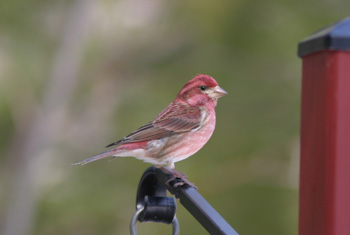
Male top and female below
The Purple Finch, Carpodacus purpureus, is a small finch.
Adults have a short forked brown tail and brown wings. Adult males are raspberry red on the head, breast, back and rump; their back is streaked. Adult females have light brown upperparts and white underparts with dark brown streaks throughout; they have a white line on the face above the eye.
Their breeding habitat is coniferous and mixed forest in Canada and the northeastern United States, as well as various wooded areas along the U.S. Pacific coast. They nest on a horizontal branch or in a fork of a tree.
Birds from northern Canada migrate to the southern United States; other birds are permanent residents.

These birds forage in trees and bushes, sometimes in ground vegetation. They mainly eat seeds, berries and insects. They are fond of sunflower seeds, millet,and thistle.
This bird has been displaced from some habitat by House Sparrows and then the introduction of House Finches in the east.
This is the state bird of New Hampshire.
Photo © Ryan Sayers
Photo © Glenn Walbek
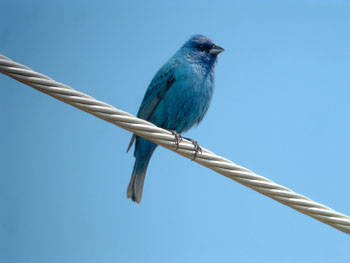
Summer visitor not found in the west.
The Indigo Bunting, Passerina cyanea, is a small seed-eating bird in the family Cardinalidae.
Adult males have deep blue plumage; the wing and tail are black with blue edges. Adult females are brown: darker on the upperparts, faintly streaked underneath.
Their breeding habitat is brushy edges across eastern North America and the southwest United States. They nest relatively low in dense shrub or a low tree. These birds are monogamous but not always faithful to their partner. In the western part of their range, they often hybridize with the Lazuli Bunting.
They migrate to southern Mexico, the West Indies and Central America. They occur in western Europe as an extremely rare vagrant.
These birds forage on the ground or in trees or shrubs. They mainly eat insects and seeds. In winter, they often feed in flocks.
The song of this bird is a high-pitched buzzed sweet-sweet chew-chew sweet-sweet.
The Indigo Bunting will migrate during the night, using the stars to direct itself. In captivity, since they cannot migrate, they experience disorientation in April/ May and in September/ October if they cannot see the stars from their enclosure.
Photo © Robert Hughes
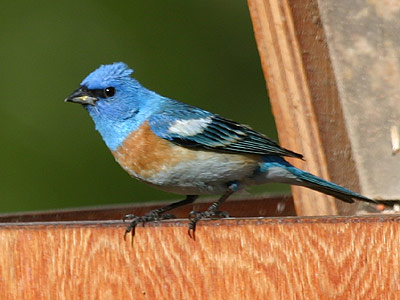
Only found in the west.
The Lazuli Bunting, Passerina amoena, is a North American songbird named for the gemstone lapis lazuli.
The male is easily recognized by its bright blue head and back (lighter than the closely related Indigo Bunting), its conspicuous white wingbars, and its light rusty breast and white belly. The color pattern may suggest the Eastern and Western Bluebirds, but the smaller size (13–14 cm or 5–5.5 inches in length), wingbars, and short and conical bunting bill quickly distinguish it. The female is brown, grayer above and warmer underneath, told from the female Indigo Bunting by two thin and pale wingbars and other plumage details.
The song is a high, rapid, strident warble, similar to that of the Indigo Bunting but longer and with less repetition.
Lazuli Buntings breed mostly west of the 100th meridian from southern Canada to northern Texas, central New Mexico and Arizona, and southern California. On the Pacific coast their breeding range extends south to extreme northwestern Baja California. They migrate to southeastern Arizona and Mexico. Their habitat is brushy areas and sometimes weedy pastures, generally well-watered, and sometimes in towns.
These birds eat mostly seeds and insects. They may feed conspicuously on the ground or in bushes, but singing males are often very elusive in treetops.
This bird makes a loose cup nest of grasses and rootlets placed in a bush. It lays three or four pale blue eggs. In the eastern and southern part of its range, it often hybridizes with the Indigo Bunting
© Tim Avery
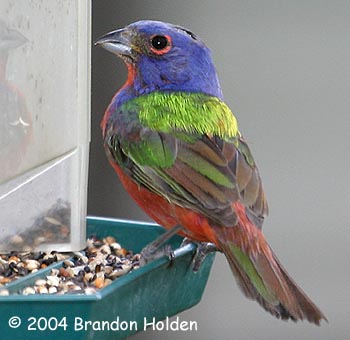
Male pictured - females are green.
The Painted Bunting (Passerina ciris) belongs to the Passerina genus of birds in the Cardinal family Cardinalidae. Nicknames: nonpareil (Fr., having no equal), Mariposa Pintada (Sp., Painted Butterfly).
The male Painted Bunting is often described as the most beautiful bird in North America. Its beautiful colors, dark blue head, green back, red rump and underparts, make it easy to identify. Their striking colors and warbled song have made them a popular cage bird in Mexico, Central America and the Caribbean. The plumage of female and juvenile Painted Buntings is green and yellow-green, serving as camouflage in thickets, woodland edges and brushy areas.
Painted Buntings are mostly monogamous and are solitary or in pairs during breeding season. They are shy, secretive and often difficult to see. Males sing from exposed perches and often hop on the ground. They eat seeds, insects and caterpillars. Populations are declining on the East Coast where habitat is being lost to development. The breeding range includes Texas, Oklahoma, Arkansas, Florida, Georgia and Louisiana. The Painted Bunting
Photo © Brandon Holden
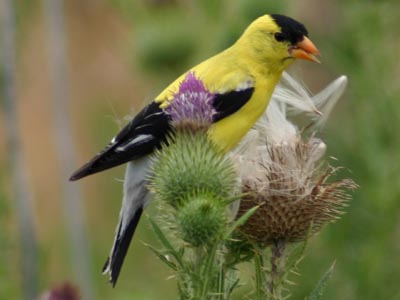
Sparrow sized with bright yellow plumage of males very distinctive. Females are grayer and browner.
It prefers trees in open places, especially in orchards and along roadsides. As winter approaches, the goldfinch moves short distances towards the south. Its winter range includes southern British Columbia, Manitoba, Ontario, New Brunswick, Nova Scotia, and most of the United States.
In spring the birds moult all but their black wing and tail feathers, and the bills of both sexes turn orange. The male assumes brilliant canary yellow plumage and a striking jet black cap; he has a very pleasing call song. In flight, a white rump contrasts with the black tail. The common winter plumage is a duller olive-brown with some yellow still showing on the head. In some winter ranges the birds lose all traces of yellow, becoming predominantly medium tan-grey banded colour, with an olive cast evident only on close viewing.
Their flight path is not straight horizontally; instead, they generally fly while going slightly up and down, making an ocean wave-shaped path. The American Goldfinch lays four to six bluish white eggs, roughly the size of peanuts.
Their favorite foods (at least in the U.S.) are thistle and teasel seeds. However, they also eat small seeds from other weeds, grasses and trees, tree buds, maple sap and sometimes insects. In winter, they are often seen in flocks.
Photo © Tim Avery
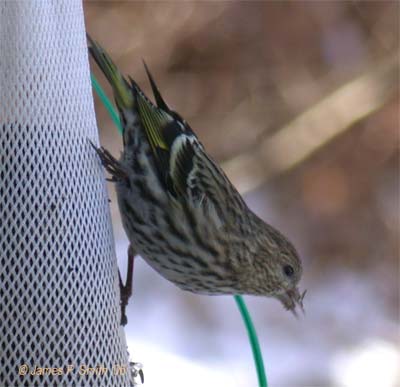
Note the yellow in wings and tail.
The Pine Siskin, Carduelis pinus, is a small finch.
Adults are brown on the upperparts and pale on the underparts, with heavy streaking throughout. They have a short forked tail. They have yellow patches in their wings and tail, not always visible; otherwise, it appears to be a very small streaked sparrow.
Their breeding habitat is across Canada, Alaska and the western mountains and northern parts of the United States. The nest is well-hidden on a horizontal branch of a tree, often a conifer.
Migration by this bird is highly variable, probably related to food supply. Large numbers may move south in some years; hardly any in others.
These birds forage in trees, shrubs and weeds. They mainly eat seeds, plant parts and some insects. In winter, they often feed in mixed flocks including American Goldfinches and redpolls.
Photo © James P Smith
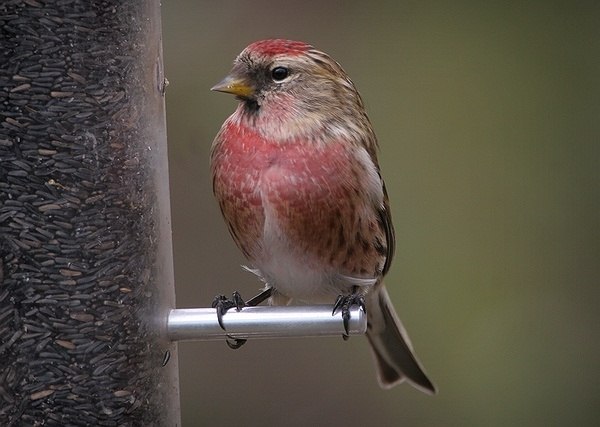
Only common in far north - note the red breast and black forehead spot.
All redpolls are northern breeding woodland species, associated with birch trees. They are small dumpy birds, brown or grey-brown above and with a red forehead patch. The adult male's breast is washed in red, but in females and young birds the buff breast and white belly are streaked with brown. The bill is small and yellow. Some birds, particularly young ones, are difficult to assign to species.
They are primarily seed-eaters, and often feed acrobatically like a tit; their diet may include some insects in summer. They have a dry reeling song and a metallic call. They lay 4-7 eggs in a nest in a tree or, in the case of Arctic Redpoll, a large bush. They can form large flocks outside the breeding season, sometimes mixed with other finches.
Photo © Sean Gray
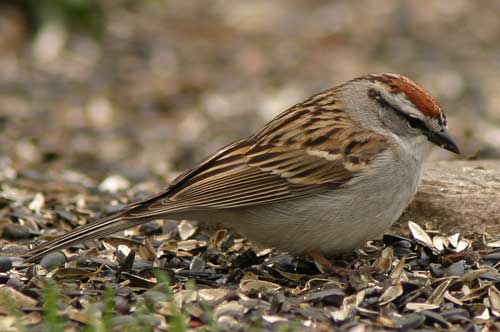
Note rufous crown and stripe through eye.
Adults have a rusty cap, a dark bill and grey underparts. They have a tan back with dark stripes, brown wings with white bars and a slim tail. Their face is grey with a black line through the eye. They are similar in appearance to the American Tree Sparrow.
Their breeding habitat is wooded areas including suburban parks and farmland across most of North America. They usually nest in trees, coniferous or deciduous, or sometimes on the ground.
These birds migrate to the southern United States and south to Mexico.
These birds forage on the ground or in low bushes, sometimes flying up to catch insects in flight. They mainly eat insects and seeds.
These birds usually travel in flocks outside of the breeding season. The song is a simple trill. Although this bird's original habitat was probably coniferous forest, it has adapted well to the changes brought about by increased human population in its range.
Photo © Ryan Sayers
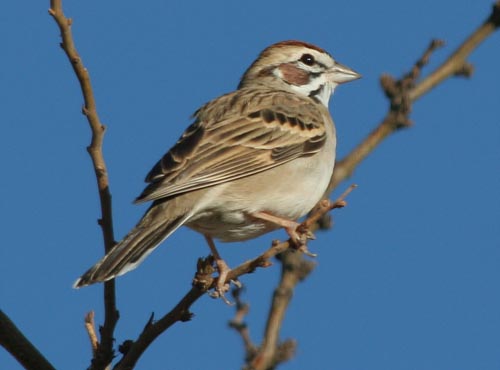
Note bold rusty head pattern.
Lark Sparrow is distinctive. Adults have a typically sparrow-like dark-streaked brown back, and white underparts except for a dark central spot. The cheeks and crown sides are chestnut, with white eyebrow and crown stripes. The dark tail's corners are also white.
Young Lark Sparrows are duller, and the underparts are streaked.
The breeding habitat is a variety of open habitats including grasslands and cultivation. Lark Sparrows nest on the ground, laying 3-6 eggs in a grass cup nest sheltered by a clump of grass or other vegetation. The eggs are white with black scrawling.
These birds forage on the ground or in low bushes. They mainly eat seeds, but insects, including grasshoppers are also eaten in the breeding season. They form flocks on migration or in winter.
The song is two clear notes followed by a mixture of buzzes and trills. The flight call is a thin sit.
Photo © Sean Cronin

Small, brown and squeaky call. Tends to prefer meadows.
Savannah Sparrow is a very variable species, with numerous races, several of which have been split as separate species at various times. The different forms vary principally in the darkness of the plumage, with Alaskan and interior races the palest, and southern Pacific coastal forms the darkest.
This species has a typically sparrow-like dark-streaked brown back, and whitish underparts with brown or blackish breast and flank streaking. It has yellowish or whitish crown and eyebrow stripes. The cheeks are brown and the throat white.
The breeding habitat is a wide variety of open habitats including grasslands and cultivation. Savannah Sparrows nest on the ground, laying 3-6 eggs in a cup nest sheltered by a clump of grass or other vegetation. They form flocks in the winter to migrate.
These birds forage on the ground or in low bushes. They mainly eat seeds, but insects are also eaten in the breeding season. The song is mixture of chips and trills. The flight call is a thin seep.
This bird was named after Savannah, Georgia where one of the first specimens of this bird was collected.
Although this bird is generally abundant across its range, some coastal populations depending on salt marsh habitat are declining.
Photo © Dave Appleton

Note the rusty color and deep bill and long tail.
Adults are heavily spotted and streaked underneath. In eastern and northern birds, the upper parts, wings, rump and tail are rusty and the underparts are white with streaks rusty to dark brown. Western birds have dark brown upperparts and dark brown streaks underneath. In some regions, western birds may have grey on the head and back.
Their breeding habitat is wooded areas across northern Canada and the west coast of North America from Alaska to California. They nest either in a sheltered location on the ground or low in trees or shrubs.
These birds migrate south on the west coast and to the eastern United States.
These birds forage by scratching the ground, which makes them vulnerable to cats and other predators. They mainly eat seeds and insects, also some berries. Birds on the coast may also eat crustaceans
Photo © Robert Hughes
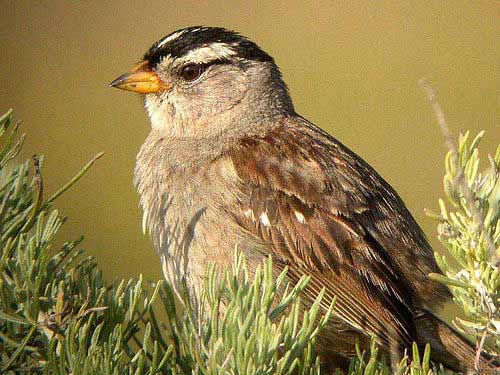
Note the stripes on the head and gray throat.
Adults have black and white stripes on their head, a grey face, brown streaked upper parts and a long tail. The wings are brown with bars and the underparts are grey. Their bill is pink or yellow. They are similar in appearance to the White-throated Sparrow but do not have the white throat markings.
Their breeding habitat is brushy areas across northern Canada and the western United States. They nest either low in bushes or on the ground under shrubs.
In some parts of the west, they are permanent residents. Northern birds migrate to the southern United States. White-crowned Sparrow is a very rare vagrant to western Europe.
These birds forage on the ground or in low vegetation, but sometimes make short flights to catch flying insects. They mainly eat seeds, other plant parts and insects. In winter, they often forage in flocks.
The call is a mournful Old Sam Peabody Peabody Peabody. (This is the white-throat song.)
The call of the white-crowned sparrow has many dialects, but the pugetensis subspecies sounds similar to "You can't come and come and catch me!"
Photo © Dave Appleton

Note the stripes on the head and white throat.
It is a North American species, breeding in central Canada and New England. It nests either on the ground under shrubs or low in trees in deciduous or mixed forest areas. In winter, it migrates to the southern USA. This bird is a rare vagrant to western Europe.
The rufous wings and white throat make this an easy species to identify. Some birds have a tan supercilium and browner head than the more common white-striped form.
These birds forage on the ground under or near thickets or in low vegetation. They mainly eat seeds, insects and berries.
Its song is a high monotone whistle with the cadence of oh sweet Canada, Canada, Canada.
Photo © Andy Pay

Note the dark bold streaks on the breast.
Adults have brown upperparts with dark streaks on the back and are white underneath with dark streaking and a dark brown spot in the middle of the breast. They have a brown cap and a long brown tail. Their face is grey with a streak through the eye. There are regional variations in this bird's appearance across its range.
Their breeding habitat is brushy areas and marshes, including salt marshes, across most of Canada and the United States. They nest either in a sheltered location on the ground or in trees or shrubs.
In southern locations, they are permanent residents. Northern birds migrate to the southern United States or northern Mexico.
Song Sparrow is a very rare vagrant to western Europe, with a few recorded in Great Britain and Norway.
These birds forage on the ground, in shrubs or in very shallow water. They mainly eat insects and seeds. Birds in salt marshes may also eat crustaceans.
This bird uses its melodious and fairly complex song to declare ownership of its territory and to attract females. It is fairly common throughout its range.
Photo © Kanae Hirabayashi